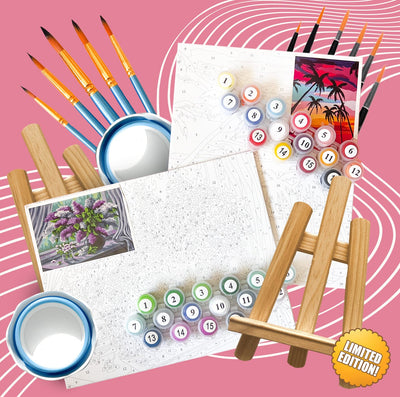If you’ve received your June art box, you might be in a fresco state of mind. To inspire your next project let’s look at some of the world’s most famous frescos. The majority that we’ve selected come from Italy, which we owe in part to the country’s dry climate, ideal for fresco production. And although we think that Italian food is already enough of a draw to warrant a trip, here are some frescoes we recommend seeing in between meals!
What is a fresco?
The fact that Italy was a key center of fresco production is obvious given the terminology surrounding this painting technique.
A fresco is a mural painting process in which painting becomes an integral part of the wall (or surface). Now here’s where your high school Italian 101 course will come in handy. The technique most frequently associated to fresco painting is “buon” or “true fresco,” which applies pigments mixed with water to a layer of wet, fresh lime mortar or plaster. But there are two other variants, “secco fresco,” which is painted onto dry plaster thus requiring a binding medium such as glue, oil or egg tempera for the painting to penetrate, and “mezzo fresco,” which is painted onto almost but not completely dry plaster.
1. Ajanta Caves (Maharashtra, India)
If you are lucky enough to find yourself in the beautiful Aurangabad district of Maharashtra, India, you must visit the Ajanta Caves! There you’ll find rock cave temples that contain rare and stunning examples of ancient Indian art made between 200 BCE and 650 CE. That includes some of the earliest fresco examples that we know today! In particular, they depict Jakata tales and stories from the life of Buddha.
2. Villa of the Mysteries (Pompeii, Italy)
Although it was a catastrophic disaster at the time of its eruption, we have Mount Vesuvius in southern Italy to thank for the preservation of Roman frescos today! The cities and surrounding areas of Pompeii and Herculaneum were buried in volcanic lava and ash in AD 79 – this caused the destruction of those civilizations, yes, but at least the artwork was preserved! This included the Villa of the Mysteries and its many frescoes, such as one that we think shows the initiation of a young woman into a Greco-Roman mystery cult.
3.Scroveni Chapel (Padua, Italy)
It’s not easy to narrow down the list of Italian Renaissance masterpiece frescoes to a top-five list. But Giotto definitely needed to make the cut! His frescoes for the jewel-like Scrovegni Chapel – commissioned by Enrico degli Scroveni – are simply mesmerizing. Completed in 1305, the frescoes theme is Salvation with an emphasis on the Virgin Mary, which befitted the chapel’s dedication to the Annunciation. Giotto is also viewed as the painter who led the transition between a flatter Medieval style of illustration to the more naturalistic one we commonly associate with the Renaissance.
4. Keldby Church (Møn, Denmark)
Frescoes from the Middle Ages are found in about 600 churches across Denmark, the highest (surviving) grouping anywhere in the world. In addition to its white chalk cliffs and stunning ocean views, the Island of Møn boasts Keldby Church, decorated with the late 15th-century frescoes depicting biblical scenes by the Elmelunde Master (in addition to some earlier frescoes). Although he worked in a unique style, which include the use of warm colors and pastels, he adhered to the style of other Danish artists working during the time, with his allover vine, flower and branch motif. Fun fact: due to the Protestant Reformation and subsequent vilification of imagery and decoration, some of Elmelunde’s frescoes were covered with whitewash, only to be undiscovered in the late nineteenth century.
5. Last Supper, Santa Maria delle Grazie (Milan, Italy)
Well we couldn’t very well write a top-five list of frescoes without including Leonardo da Vinci, could we? Completed in the late 15th century, his depiction of the biblical story, the Last Supper, as a secco fresco decorates the wall of the Convent of Santa Maria delle Grazie. Commissioned by Leonardo’s patron Ludovico Sforza, Duke of Milan, this iconic work of art has known countless copies and restoration. Protected by sandbags, it even survived the Allied bombing during World War II in 1943! And if you can’t journey to Milan, rent Mel Brooks’ film History of the World Part I for a hysterical rendition of Leonardo’s painting that never seems to get old!


